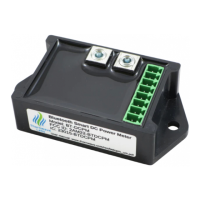5
Mounting the device
• WARNING! Do not work on a live electrical system. Disconnect the power source first!
• Attach the device to a flat surface using two screws, double sticky tape or plastic zip-ties
• Mounting on a metallic surface or inside a metal enclosed space will substantially reduce the
Bluetooth range. For best results mount in such a way so the radio signal will not be blocked.
Keep in mind that at the Bluetooth frequency of 2.4GHz the radio signal travels only in a
straight line and any obstacle in its path (walls, big metal objects) will interfere with it.
• If an external shunt is used, mount it as close as possible to the PowerMon device. The longer
the wires that connect the external shunt to the device the more electrical noise they will pick
up.
Wiring using the internal shunt (optional)
• If using the internal shunt, connect ES+ and ES- (terminals 4 and 5) together using the piece of
copper wire that was supplied with the device. Cut a shorter piece from the supplied wire and
using a pair of long nose pliers, bend it in a U shape. Insert it into terminals 4 and 5 and tighten
the terminals. There is no need to leave the wire too long – it should be flush with the terminal
block.
• Connect up to 6 AWG wires to IS+ / IS- (terminals 9 and 10). Please check the diagrams in the
user manual. For now, it does not matter which wire goes where. If IS+ / IS- are swapped the
sign of the current reading changes. The target is to get the current to display positive when the
battery is charging and negative when discharging. If the current sign is backwards, either swap
the wires into IS+ / IS- (terminals 9 and 10) or enable the “Flip Current Sign” option in the
device configuration.
Wiring using an external shunt (optional)
• If using an external shunt connect ES+ / ES- (terminals 4 and 5) to the measurement points on
the shunt. Typically, these are smaller screws positioned inside of the larger high current
connections of the shunt. Keep the wires as short as possible. Twisting them will reduce the
noise even further. Avoid running these wires parallel to high current carrying wires. Doing so
will introduce unwanted noise into the measurements. The target is to get the current to
display positive when the battery is charging and negative when discharging. If the measured
current has the wrong sign, there is no need to reverse the wires. The current sign can be
flipped using the “Flip Current Sign” option in the device configuration.
• Connect the high current lugs of the external current shunt using wires of adequate size.
Crimping of battery lugs may be required.
• Do not connect terminals 9 and 10!

